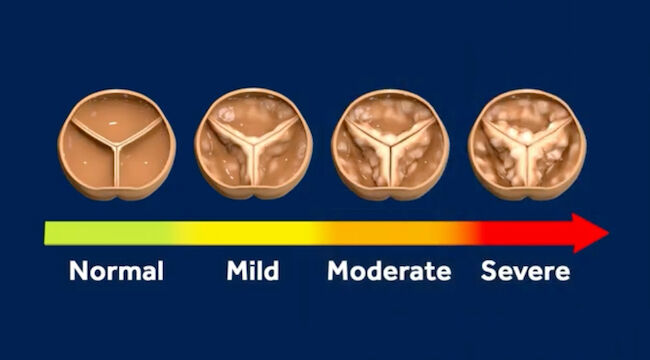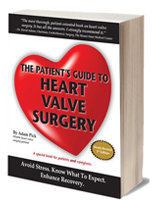Moderate Aortic Stenosis Risks: What Should Patients Know?
Written By: Allison DeMajistre, BSN, RN, CCRN
Medical Expert: Ibrahim Sultan, MD, Chief of Cardiac Surgery, University of Pittsburgh Medical Center, Pittsburgh, Pennsylvania
Medically Reviewed By: Adam Pick, Patient Advocate, Website Founder, Author
Published: May 6, 2025
Aortic valve stenosis is the narrowing of the aortic valve and is classified as mild, moderate, or severe. When stenosis is severe, valve replacement is required. Otherwise, “watchful waiting” is the recommended treatment for patients in the mild or moderate phase. Aortic stenosis is a progressive disease, and it can take several years to advance from mild or moderate to severe, but it can also advance very quickly and worsen within a matter of months. For this reason, patients have many questions about the disease, especially when they start developing symptoms like shortness of breath, chest pain, or fatigue.
We received a great patient question on this topic from Denise, who asked, “I have moderate aortic stenosis. I feel short of breath and tired at times. What are the dangers and risks of moderate aortic stenosis?” We were thrilled to have Dr. Ibrahim Sultan join us at the Society of Thoracic Surgeons Conference in Los Angeles to answer Denise’s question. Dr. Sultan is the Chief of Cardiac Surgery at UPMC in Pittsburgh, Pennsylvania.
About the Risks of Moderate Aortic Stenosis
Here are the key insights shared by Dr. Sultan:
- It’s imperative to assess the severity of aortic stenosis. “We see patients in the office with moderate aortic stenosis, such as Denise, that have symptoms,” stated Dr. Sultan. “The first thing I look at is if they really have moderate aortic stenosis. There are a variety of different ways to measure aortic stenosis or aortic gradients. If your heart happens to be a little bit weak or a little bloated, or if you have a significant leak across the aortic valve, your moderate aortic stenosis may actually be worse than what’s described.”

- Early intervention for moderate aortic stenosis should be avoided. Dr. Sultan explained, “One of the most dangerous things about moderate aortic stenosis is that it can progress to severe aortic stenosis. What we don’t want to do is intervene too early, before therapy is needed. Now, what it does is it resets the clock. Since Denise has her own native valve, we can wait until it’s truly diseased before we replace it because the mortality, whether it’s TAVR or heart surgery, is still not zero consistently. It’s exceedingly low and exceedingly safe, but it’s still not zero.”
- Regular monitoring will prevent the progression of the disease from becoming a potential risk. “I would suggest ensuring that the testing is done appropriately and at regular intervals,” said Dr. Sultan. “So, we can surveil what the valve looks like and ensure that it is truly moderate aortic stenosis, particularly when Denise is feeling these symptoms.”
Thanks Dr. Sultan and UPMC!
On behalf of Denise and all the patients in our community, thank you for everything you and your team are doing at the University of Pittsburgh Medical Center in Pittsburgh, Pennsylvania!
Related Links:
- Ibrahim Sultan, MD: Heart Surgeon in Pittsburgh, Pennsylvania
- Surgeon Q&A: Timing & Tests for Aortic Aneurysm & Bicuspid Valves
Keep on tickin,
Adam
P.S. For the deaf and hard-of-hearing members of our patient community, we have provided a written transcript of our interview with Dr. Sultan below.
Video Transcript:
Adam Pick: Hi everybody. It’s Adam with HeartValveSurgery.com and we are in Los Angeles, California at the Society of Thoracic Surgeons Conference. I am thrilled to be joined by Dr. Ibrahim Sultan, who is the Chief of Cardiac Surgery at UPMC in Pittsburgh, Pennsylvania. Dr. Sultan. It’s great to see you again here at STS.
Dr. Ibrahim Sultan: Great to see you Adam.
Adam Pick: We’re here at STS and physicians from all over the world talking about the latest treatments in valve therapy. At the same time, we’re getting questions from patients who need help and to educate them.
We got a question from Denise who asks, “Hi Adam, I have moderate aortic stenosis. I feel shorter breath and tired at times. What are the dangers and risks of moderate aortic stenosis?”
Dr. Ibrahim Sultan: That’s a great question. And we see patients in the office who come with moderate aortic stenosis, such as Denise, that have symptoms.
The first thing I look at is… Do they really have moderate aortic stenosis? Because there’s a variety of different ways to measure aortic stenosis or aortic gradients. If your heart happens to be a little bit weak or a little bit bloated, or if you have significant leak across the aortic valve, it’s possible that your moderate aortic stenosis may actually be worse than what’s described.
Now, the other way to look at it is one of the most dangerous things about moderate aortic stenosis is that it can progress to severe aortic stenosis. What we don’t want to do is intervene too early before therapy is needed. Now, what it does is it resets the clock. Now that Denise has her own native valve, we can wait as long as that’s truly diseased before we replace it.
Because the mortality, whether it’s TAVR or heart surgery, is still not zero consistently. It’s exceedingly low and it’s exceedingly safe. But, it’s still not zero. And so, what I would suggest is to ensure that the testing is done appropriately. It’s done at routine intervals. So, we can surveil what this valve looks like, and ensure that it truly is moderate aortic stenosis, particularly when Denise is feeling these symptoms.
Adam Pick: Wow, well thank you so much, Denise. I hope that helped you, and I love how you commented on the regular monitoring and tracking of the disease to ensure. So, progression doesn’t lead to more potential risk for Denise. On behalf of Denise and patients all over the world, Dr. Sultan, thanks for everything you and your team are doing at UPMC in Pittsburgh, Pennsylvania.
Thanks for being with me today.
Dr. Ibrahim Sultan: Thank you, Adam.





